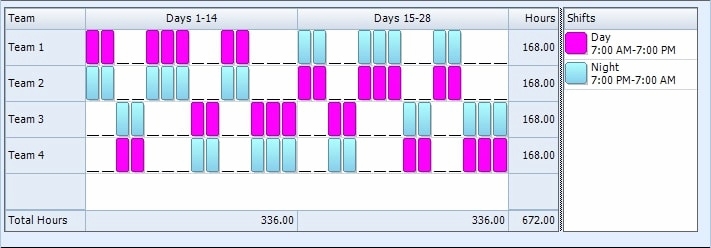Introducing the innovative and dynamic world of work scheduling: the 2-2-3 schedule. As companies move beyond the 9-to-5 model, a flexible schedule is an alternative. Now employees achieve better work-life balance while meeting organizational needs.
The 2 2 3 work schedule is fixed. It means two business days on, two days off, and three days on. It moves away from the usual Monday-to-Friday workweek. This shift is more flexible. The 2-2-3 schedule adapts to the needs of individuals and various industries. Join us as we explore this work schedule. It combines routine with adaptability for a better, more efficient workplace.
What Is a 2-2-3 Schedule?
So, what is a 2-2-3 work schedule all about? It’s a new way to organize work time. It breaks from the usual Monday-to-Friday routine.
Basically, a 2/2/3 schedule means employees work for two days, and take two days off. After that, they work for three days straight. This cycle repeats all week, creating a new rhythm. It’s not your typical workweek beat.

This 2-2-3 schedule is flexible. It meets the varied needs of employers and employees. Breaks between workdays help employees recharge and maintain a better work-life balance. Employers benefit from reduced burnout, happier staff, and improved productivity. In its simplicity, this schedule shakes up our traditional views on work schedules.
Industries Embracing the 2-2-3 Schedule
The 2 2 3 schedule is popular for its flexibility and balance. It is favored in industries seeking modern work schedules.
1️⃣ Healthcare and nurse schedules need careful planning to ensure continuous patient care. The 2-2-3 schedule helps. It provides consistent staffing and gives doctors time to rest. This approach supports both patient care needs and the well-being of the staff.
2️⃣ Manufacturing is another sector that has adopted the 2-2-3 schedule. The structured pattern aligns with the demands of round-the-clock manufacturing operations. It not only enhances productivity but also contributes to employee well-being.
3️⃣ The 2-2-3 schedule can cover extended hours for call centers scheduling. This ensures that customer inquiries are addressed promptly, contributing to higher customer satisfaction.
4️⃣ The aviation industry has also implemented the schedule. This is clear in the well-known Panama shift. It is a variation of the 2-2-3 schedule used in airline operations. It ensures flight crews are always available. Also, it complies with the required rest periods.
Types of 2-2-3 Schedules: Exploring Variations:
The 2-2-3 schedule has a fixed shift. It gives employees a steady routine. They work for two days, then have two days off, followed by three workdays. This structure is easy to follow and ensures a consistent work-life balance.
Fixed 2-2-3 schedule
The fixed shift 2-2-3 schedule is a routine. Employees work two days, get a two-day break, then work three days. This straightforward structure simplifies planning and allows for a predictable work-life balance.
✅ Pros:
Predictability: The fixed schedule lets employees plan their commitments.
Routine: It creates structure and familiarity in the workplace.
❌ Cons:
Limited flexibility: The fixed schedule is not adaptable, making unexpected changes challenging.
Rotating 2-2-3 schedule
In the rotating shift 2-2-3 schedule, employees alternate shifts and workdays. This ensures a fair distribution of work hours. This approach also meets the varied staffing needs across different periods.
✅ Pros:
Equitable work distribution: Ensures fair allocation of work hours among team members.
Flexibility: Allows for adaptability to changing staffing requirements and operational demands.
❌ Cons:
Disrupted routine: It may disrupt routines and affect personal plans.
Dupont shift schedule
The Dupont shift schedule extends the 2-2-3 pattern over four weeks. It provides longer off periods. This schedule is often used in industries with specific regulatory requirements.
✅ Pros:
Extended time off: Employees benefit from longer breaks between work cycles.
Regulatory compliance: Meets specific regulatory requirements for rest intervals in certain industries.
❌ Cons:
Longer work shifts: The extended schedule may involve longer shifts, causing fatigue.
Modified 2-2-3 schedule
The modified 2-2-3 schedule adjusts the standard shift pattern. It aims to meet the specific needs of some industries.
✅ Pros:
Tailored to industry needs: It allows custom scheduling for specific requirements.
Operational flexibility: Provides flexibility in adapting to the unique demands of the workplace.
❌ Cons:
Potential complexity: Modifications may introduce complexity in scheduling and require careful management.
Panama shift (Extended 2-2-3 schedule)
The Panama shift is an extended version of the 2-2-3 schedule, often used in 24/7 industries like aviation. Usually, this schedule includes four teams. Each works for two consecutive days, then has two rest days, and finally works for three days.
✅ Pros:
Continuous coverage: Enables industries with round-the-clock operations to maintain continuous coverage.
Regulatory compliance: Adheres to regulations governing rest intervals for employees in specific sectors.
❌ Cons:
Extended work hours: Longer shifts may increase fatigue and worsen employee well-being.
2-2-3 Schedule: Pros and Cons
✅ Pros
Enhanced work-life balance
The 2-2-3 schedule gives employees more consecutive days off than traditional schedules. It balances work and personal life. Longer breaks contribute to reduced burnout and improved overall well-being.
Flexibility in scheduling
Organizations can use the schedule to meet specific operational needs or industry requirements. Increased flexibility allows for better accommodation of varying workloads.
Continuous operational coverage
Industries like healthcare and manufacturing benefit from the 2-2-3 schedule. It ensures consistent operations. This structure maintains continuous coverage without overburdening workers.
Improved productivity
Employees might have higher productivity due to increased focus during shorter, consecutive workdays.
Variations for diverse needs
The 2-2-3 schedule has adaptations for different industries’ needs. They include rotating, fixed, and Panama shifts.
❌ Cons
Disrupted weekly routine
Alternating workdays in the 2-2-3 schedule can disrupt employees’ weekly routines. This unpredictability may make personal planning more challenging.
Communication challenges
When employees have different days off, coordinating schedules can become challenging. This misalignment may lead to communication issues within the team.
Fatigue concerns
Longer workdays in 2-2-3 schedules, like the Panama Shift, can cause fatigue. Over time, this may increase the risk of burnout.
Limited adaptability
The 2-2-3 schedule may be too rigid for sudden changes in workload or staffing. This rigidity can make it challenging to handle unexpected demands.
Potential resistance to change
Employees used to standard work arrangements may need help with the new schedule. Adapting to a new structure can take time and effort.
Effective Management of the 2-2-3 Schedule
A 2-2-3 schedule needs careful planning. It must balance efficiency and employee satisfaction. Attention to both logistics and team needs is essential for success.
🗣️ Communication and collaboration
Proactive communication: Keep communication open to ensure everyone is informed about schedule changes. This clarity helps the team stay aligned and avoid misunderstandings.
Collaborative tools: Use scheduling tools to help teams coordinate in a 2-2-3 schedule.
🤹♀️ Adaptability and flexibility
Responsive to changes: Adapt to changes in workloads or unforeseen events. They may require schedule adjustments.
Employee input: Ask for feedback on the schedule. Be open to adjusting it based on their suggestions.
👩🏫 Employee training and support
Training programs: Train employees on the 2-2-3 schedule, its variations, and tools.
Support mechanisms: Create systems to help employees adapt to the new schedule.
💡 Clear policies and procedures
Transparent guidelines: Define policies on the schedule. Include expectations for attendance, time tracking, and workdays.
Procedure documentation: Create clear docs for schedule changes, conflict resolution, and time-off requests.
👩💻 Utilization of technology
Scheduling software: Use scheduling software to simplify planning and shift management.
Communication platforms: Use efficient tools for real-time updates and team collaboration. This helps improve coordination and ensures that everyone stays informed.
📈 Performance monitoring and feedback
Regular check-ins: Check in with employees to see how they are. Get their feedback on the schedule. This helps spot any problems and make changes to improve work and satisfaction.
Performance metrics: Assess the schedule’s impact on productivity, employee happiness, and results.
😒 Addressing fatigue and burnout
Monitoring workload: Distribute workloads evenly to avoid burnout. This is important in sectors with long shifts. Regularly check if the distribution is fair to ensure no one is overburdened.
Wellness initiatives: Offer wellness programs to support employee health and reduce fatigue. These initiatives can include physical activities, mental health resources, and stress management practices. They aim to keep workers energized and productive.
↗️ Continuous improvement
Feedback loops: Establish continuous feedback loops to address any challenges that arise.
Adaptation strategies: Adjust the schedule for its effectiveness and your changing workforce. Regular reviews can help ensure the schedule continues to benefit everyone.
Embracing Balance and Efficiency with the 2-2-3 Work Schedule
So, what is a 2 2 3 work schedule? In conclusion, balancing operational efficiency with employee well-being is a dynamic solution. Its versatility, shown in variations like the Panama shift, meets diverse industry needs. This schedule becomes a valuable tool as businesses adapt to new work structures. It supports a balance between productivity and flexibility, helping to improve work-life harmony. This structure allows organizations to be more adaptable while maintaining efficiency.
In case you want to improve shift planning, try Shifts by Everhour. It is the perfect solution. Real-time monitoring, easy scheduling, and mobile access make workforce management simpler. It’s also great for complex teams, like law enforcement. Thus, efficient police department scheduling software is essential.

